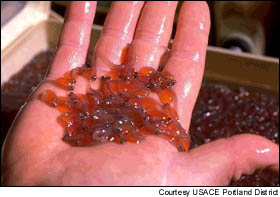forum
library
tutorial
contact

Draft Policy on Hatchery Salmon Flawed,
Scientists Say
by Jeff Barnard, Associated Press
Seattle Post-Intelligencer, August 28, 2004
|
the film forum library tutorial contact |

|
Draft Policy on Hatchery Salmon Flawed,
by Jeff Barnard, Associated Press
|
 GRANTS PASS, Ore. -- The proposed new federal policy for salmon hatcheries is based on a flawed reading of the Endangered Species Act, hindering efforts to restore wild salmon runs with hatchery fish, scientists say.
GRANTS PASS, Ore. -- The proposed new federal policy for salmon hatcheries is based on a flawed reading of the Endangered Species Act, hindering efforts to restore wild salmon runs with hatchery fish, scientists say.
"The overarching problem is that the ESA is being administered as a fisheries management policy, not as a statute to protect endangered species," a group of scientists said in a letter to National Oceanic and Atmospheric Administration Fisheries.
The scientists were formally commenting on a new federal policy for salmon hatcheries that was prompted by a 2001 federal court ruling giving hatchery fish the same protection as wild fish. The public comment period on the draft policy has been extended to Oct. 22 to include a series of public hearings.
The 11 scientists, most of them retired, are from universities, businesses, and state, federal and tribal fisheries agencies. They have worked together in the past and gather periodically to discuss fisheries issues.
The group includes James Lannan, a retired Oregon State University geneticist who was an expert witness in the federal lawsuit that prompted the new hatchery policy.
It also includes Andre Talbot, who works for the Columbia River Inter-Tribal Fish Commission, which has called for using hatchery fish to rebuild protected wild runs.
"I think our only concern is to bring some sort of intellectual honesty into the process," Lannan said.
"If you go with just natural production, you won't have any fisheries. If you go just with hatcheries, you give up a lot in terms of the ecological advantages of maintaining natural production at significant levels. But if you can put the two together in an intelligent way, you can have the best of both worlds," he said.
The letter said the hatchery policy was pointed in the right direction but ran into problems because the basic unit for dividing the six species of salmon and steelhead into 51 smaller groups for endangered species listings does not conform with the basic unit defined in the Endangered Species Act.
The new hatchery policy opened the way for supplementing declining wild salmon runs with hatchery fish.
The practice is advocated by Indian tribes that depend on salmon for food, jobs and cultural use, and property rights groups, which object to restrictions on land use intended to protect fish habitat.
It is opposed by environmentalists and wild salmon advocates who argue hatcheries produce fish less able to survive in the wild.
NOAA Fisheries spokesman Brian Gorman said the scientists were raising "a non-issue" about a policy that "was very carefully thought out and thoroughly vetted in a peer-reviewed scientific process."
The scientists said the so-called evolutionarily significant unit used by NOAA Fisheries to list salmon as threatened or endangered does not conform to the definition of a distinct population segment required in the Endangered Species Act.
Members of a distinct population segment interbreed, but an evolutionarily significant unit includes fish living in separate rivers, where they do not spawn together, the scientists said.
This can lead to genetically inappropriate fish being used to supplement wild populations, the scientists said.
learn more on topics covered in the film
see the video
read the script
learn the songs
discussion forum
